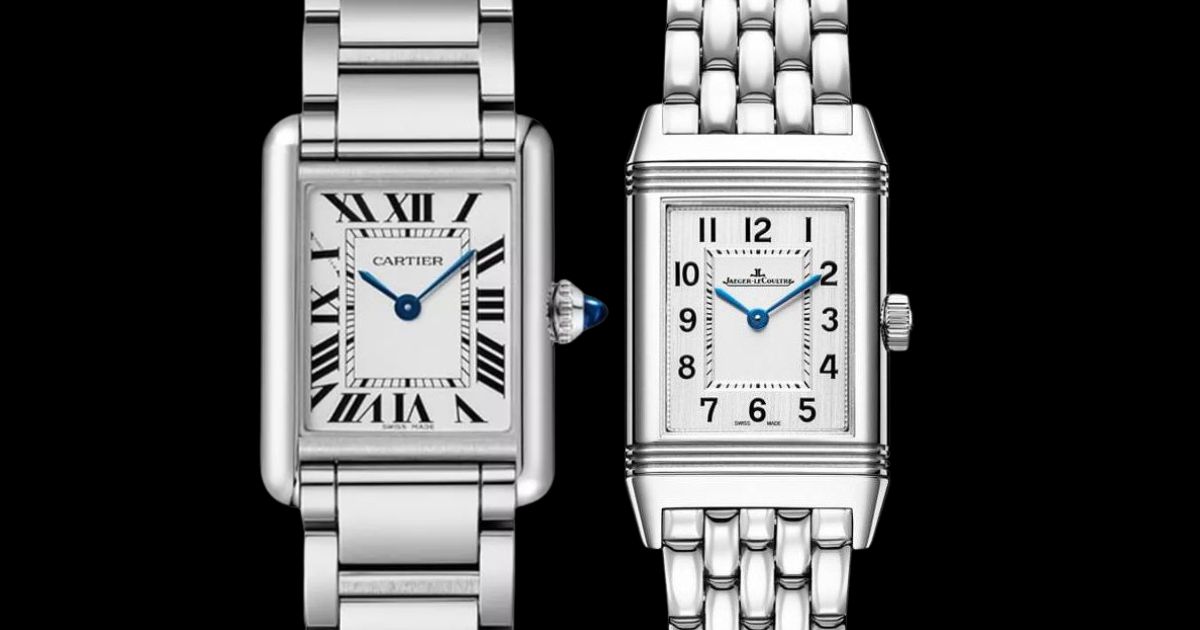Our Magazine
Battle of the Icons: Cartier Tank vs. Jaeger-LeCoultre Reverso

In the rarefied world of horology, where debates over the “greatest” watch can fuel conversations for hours, few rivalries are as elegant, enduring, and intellectually satisfying as the one between the Cartier Tank and the Jaeger-LeCoultre Reverso. These are not mere time-telling instruments; they are wearable sculptures, born from distinct moments of genius, that have come to define the very essence of rectangular dress watches.
Choosing between them is a rite of passage for any collector. It’s a decision that speaks less about telling time and more about personal narrative, aesthetic alignment, and what you value in a watch’s soul. So, let’s pull up a chair, pour a neat dram of your favourite single malt, and delve into the glorious battle of these two icons.
The Cartier Tank: The Parisian Poet
A Story Born from the Trenches
The Tank’s origin is as legendary as its design. Created in 1917 by Louis Cartier, its inspiration was starkly modern for its time: the Renault FT-17 tanks seen on the Western Front of World War I. Cartier transformed the brutal, functional silhouette of a war machine into an object of pure elegance. The parallel brancards (the vertical sides of the case) represent the tank’s tracks, while the case itself is the cockpit.
This act of alchemy—turning war into peace, steel into style—is the very heart of the Tank. It wasn’t designed for a specific function beyond telling time and, more importantly, adorning the wrist with impeccable taste.
The Hallmarks of Design
What makes a Tank a Tank?
-
The Silhouette: It is a study in perfect proportions. The clean, Roman numeral dial, the chemin de fer (minute track), the blued-steel hands (the “apple” shape of the Louis model is particularly beloved), and the sapphire cabochon set into the crown create a harmonious whole that feels both balanced and bold.
-
The Wrist Presence: The Tank is not a watch that shouts. It whispers. It’s an extension of the wearer’s personal style. On the wrist, it sits flat and discreet, a sliver of refined geometry that complements a suit cuff or a bare wrist with equal grace. It’s a watch that is often noticed but rarely examined, a secret handshake among those with an eye for design.
-
The Soul: The Tank is, first and foremost, a design object from the house of a jeweller. Its primary genius lies in its timeless aesthetic. It is the watch of Andy Warhol, Princess Diana, and Yves Saint Laurent—artists and icons who understood its power as a symbol of cultivated taste. Owning a Tank is an affirmation of style over sheer technical bravado.
The Jaeger-LeCoultre Reverso: The Engineer's Canvas
A Story Born from the Polo Field
A decade after the Tank’s debut, the Reverso emerged from a different world entirely: the sporting fields of British Colonial India in 1931. The story goes that polo players challenged the Swiss watchmakers to create a timepiece that could survive the rigours of a chukka. The solution was as ingenious as it was simple: a case that could slide out of its frame and flip over, protecting the fragile crystal and dial.
Where the Tank was born from aesthetic inspiration, the Reverso was born from a practical problem. This fundamental difference in origin story defines their characters to this day.
The Hallmarks of Design
What makes a Reverso a Reverso?
-
The Art Deco Mechanism: The flipping case is a masterpiece of engineering. The sleek, longitudinal grooves, the satisfying click as it reverses, and the perfect alignment are a tactile joy. It’s a feature you find yourself playing with, a constant reminder of the mechanical intelligence within.
-
The Double Identity: The reversible case unlocked a world of possibilities. The blank metal back became a canvas for personalisation—engravings, enamel paintings, or even a second timezone. This “second face” gives the Reverso a deeply personal dimension. It can carry a family crest, a lover’s initials, or a beautiful miniature painting, turning the watch into a private, wearable secret.
-
The Soul: The Reverso is the ultimate expression of the “watchmaker’s watch.” It hails from Jaeger-LeCoultre, the “Grande Maison” of the Vallée de Joux, renowned for its immense in-house manufacturing capabilities. While elegant, its soul is technical. Owning a Reverso is an appreciation for mechanical ingenuity, for a solution that is as beautiful as it is clever.
The Head-to-Head: Where Do They Diverge?
So, when you’re trying to choose, where should you look?
-
Wrist Feel & Wearability: The Tank is often flatter and sits more like a piece of jewellery. Its elegance is in its two-dimensional profile. The Reverso, due to its sliding mechanism, has more height and a distinctly architectural, three-dimensional presence on the wrist. It feels more like a precision instrument.
-
The Dial & Legibility: Cartier dials are iconic and consistent. They are design statements. Jaeger-LeCoultre’s Reverso dials are more varied, often leaning into a more classic, horological presentation with applied markers and a focus on perfect finish. The Reverso’s dial can feel more “serious” and less “decorative” than the Tank’s.
-
The Personal Connection: Do you want a watch that is a perfect, finished statement (Tank), or one that invites personalisation and has a hidden, interactive element (Reverso)? The Tank’s story is complete upon purchase. The Reverso’s story often begins there, with the potential for a personal engraving or a customised back.
The Verdict: A Draw, Defined by You
In the end, there is no winner in this battle, only a winner for you.
Choose the Cartier Tank if: Your heart skips a beat for pure, unadulterated design. You see your watch as the final, perfect accessory to your personal style. You value timeless elegance, historical connection to the art and fashion world, and a watch that is an undeniable icon at a single glance.
Choose the Jaeger-LeCoultre Reverso if: You are fascinated by mechanics and story. You love the tactile interaction of flipping the case and the idea of a hidden, personal canvas. You respect the deep horological pedigree of a manufacture and appreciate a watch that is as much an engineering marvel as it is a stylish companion.
One is a poet who speaks in perfect verses of line and form. The other is an architect who builds ingenious, interactive structures for the wrist. Both are pinnacles of watch culture. The true luxury is not in choosing one over the other, but in understanding the story each tells and deciding which story you want to wear on your wrist. For many of us, the dream collection has room for both.













